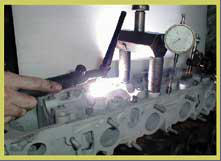























Head engine problem Brisbane - BENT
Cylinder heads bend as the result of overheating. In OHV pushrod engines the bend in a cylinder head is often ignored and a surface grind to repair the face is all the repair that is necessary. OHC engines suffer a different fate if cylinder head bend is ignored. Once an OHC head bends it is necessary to straighten the cylinder head before a surface grind is carried out. The straightening process is to ensure the camshaft turns freely and does not seize after the fitting of a new head-gasket or rebuild. Engine reconditioners may use a few different methods of head straightening. If heat is used to prepare the head for straightening care has to be taken to ensure the head is not heated over 250-300 degrees C. Severe damage can occur to a head such as inserts coming loose, valve guides moving and worst of all alloy heads can become soft and unserviceable. A new method has been developed that eliminates the need for heat, so the risk of damage is reduced.. Straightening severely bent heads carries a high risk of cracking and in these cases it is desirable to replace the head rather than repair it. The allowable bend in most OHC heads is around .005" to.006" (5 to 6 thousandths of an inch.). It is advisable to check how easy the camshaft turns in the head without any valves fitted. The camshaft must spin freely without any drag. Failing this, head straightening or tunnel boring is required. Surface grinding a cylinder head may reduce it's overall head thickness to below the allowable limits. If this problem goes unchecked and a below minimum thickness head is refitted some running problems could occur. After market gasket manufacturers have produced head gasket shims to rectify this problem. Disclaimer Agreement : Every care has been taken in writing this information and procedures, but no responsibility can be excepted for errors, omissions or misuse of this information and procedures. The information available on this site is for your instruction only and cannot be copied for sale, © copyright 2001 UMR Engines



Remachining face of
cylinder head
Controlled staightening
of cylinder head
Camshaft tunnels picked
up due to bend in head





















•
Queensland Transport Authorised to approve LA1,LA3,LB1,LD1-2,LK1,LK6 Modification’s to light vehicles
•
LPG Approved Workshop
•
RWC Licence
•
RACQ Approved Automotive Repairer





Head engine problem Brisbane - BENT
Cylinder heads bend as the result of overheating. In OHV pushrod engines the bend in a cylinder head is often ignored and a surface grind to repair the face is all the repair that is necessary. OHC engines suffer a different fate if cylinder head bend is ignored. Once an OHC head bends it is necessary to straighten the cylinder head before a surface grind is carried out. The straightening process is to ensure the camshaft turns freely and does not seize after the fitting of a new head-gasket or rebuild. Engine reconditioners may use a few different methods of head straightening. If heat is used to prepare the head for straightening care has to be taken to ensure the head is not heated over 250-300 degrees C. Severe damage can occur to a head such as inserts coming loose, valve guides moving and worst of all alloy heads can become soft and unserviceable. A new method has been developed that eliminates the need for heat, so the risk of damage is reduced.. Straightening severely bent heads carries a high risk of cracking and in these cases it is desirable to replace the head rather than repair it. The allowable bend in most OHC heads is around .005" to.006" (5 to 6 thousandths of an inch.). It is advisable to check how easy the camshaft turns in the head without any valves fitted. The camshaft must spin freely without any drag. Failing this, head straightening or tunnel boring is required. Surface grinding a cylinder head may reduce it's overall head thickness to below the allowable limits. If this problem goes unchecked and a below minimum thickness head is refitted some running problems could occur. After market gasket manufacturers have produced head gasket shims to rectify this problem. Disclaimer Agreement : Every care has been taken in writing this information and procedures, but no responsibility can be excepted for errors, omissions or misuse of this information and procedures. The information available on this site is for your instruction only and cannot be copied for sale, © copyright 2001 UMR Engines



Remachining face of
cylinder head
Controlled staightening
of cylinder head
Camshaft tunnels picked
up due to bend in head




7 Moss Street, Slacks Creek, Qld 4127




































